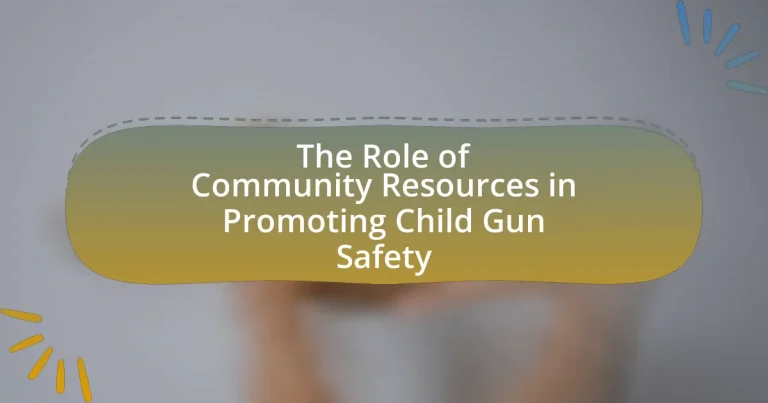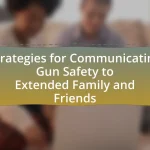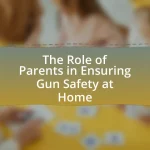The article focuses on the critical role of community resources in promoting child gun safety. It highlights how local organizations, schools, and law enforcement agencies provide education, support, and access to safety programs that teach safe gun handling and storage practices. The article discusses various community initiatives, such as workshops and gun buyback programs, that aim to reduce accidental shootings among children. It also addresses the challenges faced by these resources, including funding limitations and societal attitudes, while emphasizing the importance of collaboration among stakeholders to enhance gun safety efforts. Additionally, it explores innovative strategies and the impact of data-driven approaches in shaping effective community interventions for child gun safety.
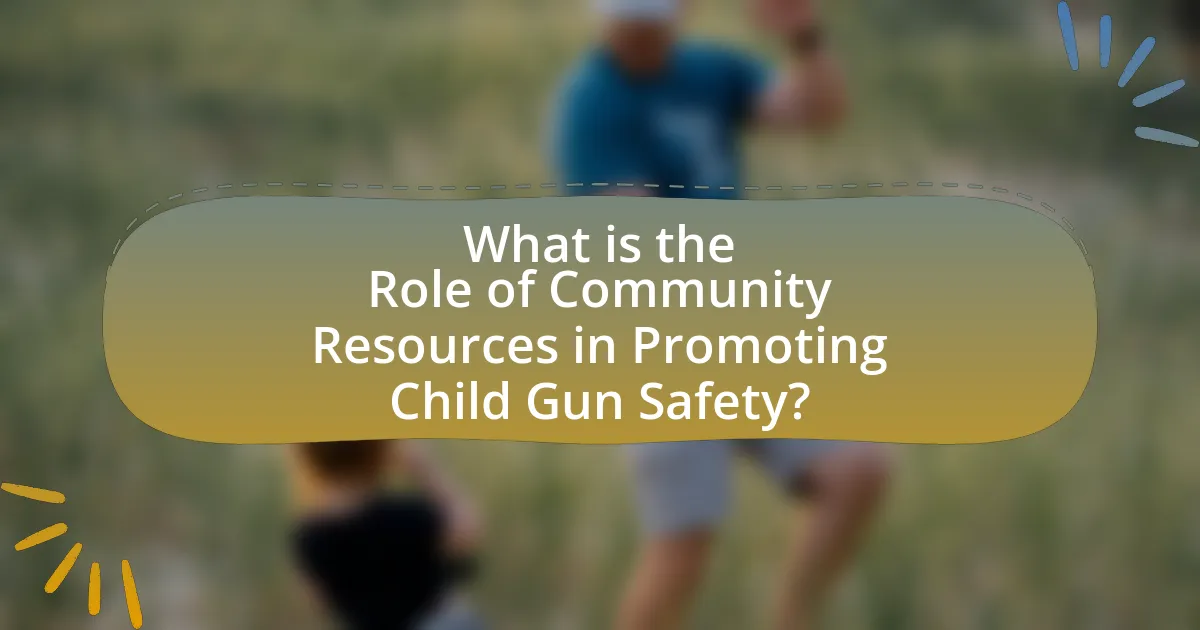
What is the Role of Community Resources in Promoting Child Gun Safety?
Community resources play a crucial role in promoting child gun safety by providing education, support, and access to safety programs. These resources, such as local organizations, schools, and law enforcement agencies, facilitate workshops and training sessions that teach children and parents about safe gun handling and storage practices. For instance, the National Shooting Sports Foundation reports that community-based programs can significantly reduce accidental shootings among children by increasing awareness and knowledge about firearm safety. Additionally, community resources often collaborate with health departments and advocacy groups to distribute educational materials and implement safety initiatives, further reinforcing the importance of responsible gun ownership and child safety.
How do community resources contribute to child gun safety initiatives?
Community resources significantly enhance child gun safety initiatives by providing education, support, and access to safety programs. Local organizations, schools, and health departments often collaborate to offer workshops that teach children and parents about gun safety practices, such as safe storage and the importance of reporting unsafe situations. For instance, the American Academy of Pediatrics emphasizes that community-based programs can reduce firearm-related injuries among children by promoting awareness and responsible gun ownership. Additionally, resources like gun buyback programs and safety lock distribution initiatives directly contribute to reducing the number of firearms accessible to children, thereby decreasing the risk of accidental shootings.
What types of community resources are available for promoting gun safety?
Community resources available for promoting gun safety include educational programs, local advocacy groups, and gun safety training courses. Educational programs often focus on teaching children and parents about safe gun handling and storage practices, while local advocacy groups work to raise awareness and support legislation aimed at reducing gun violence. Gun safety training courses, often provided by certified instructors, equip individuals with the knowledge and skills necessary to handle firearms responsibly. These resources are essential in fostering a culture of safety and responsibility within communities, ultimately contributing to the reduction of gun-related incidents.
How do these resources engage with families and children?
Community resources engage with families and children by providing educational programs and workshops focused on gun safety. These initiatives often include hands-on activities, discussions, and materials that emphasize the importance of safe gun storage and responsible behavior around firearms. For instance, organizations like the National Shooting Sports Foundation offer resources that help families understand the risks associated with guns and promote safe practices, which can lead to a measurable decrease in accidental shootings among children. Additionally, community events often involve local law enforcement, which fosters trust and encourages open dialogue about safety concerns, further enhancing the engagement of families and children in these critical conversations.
Why is child gun safety a critical issue in communities?
Child gun safety is a critical issue in communities because it directly impacts the well-being and lives of children. Statistics indicate that in the United States, nearly 4.6 million children live in homes with at least one loaded and unlocked firearm, significantly increasing the risk of accidental shootings and suicides among youth. Research from the American Academy of Pediatrics shows that unintentional firearm injuries are a leading cause of death for children, highlighting the urgent need for effective community resources and education on safe gun storage practices. Furthermore, community initiatives that promote awareness and provide resources can significantly reduce these risks, fostering safer environments for children.
What statistics highlight the importance of addressing child gun safety?
In the United States, approximately 4.6 million children live in homes with at least one loaded and unlocked firearm, highlighting the critical need for addressing child gun safety. Research indicates that unintentional shootings involving children occur at an alarming rate, with the Centers for Disease Control and Prevention reporting that firearms are the second leading cause of death for children aged 1 to 19. Furthermore, a study published in the journal “Pediatrics” found that nearly 1 in 3 children aged 5 to 14 years reported having access to a gun in their home, underscoring the urgency of implementing effective safety measures and community resources to prevent gun-related incidents among children.
How do community demographics influence gun safety concerns?
Community demographics significantly influence gun safety concerns by shaping perceptions of risk and the prevalence of gun-related incidents. For instance, communities with higher poverty rates often experience increased gun violence, leading to heightened safety concerns among residents. According to a study by the American Journal of Public Health, neighborhoods with lower socioeconomic status report more frequent gun-related crimes, which directly correlates with community anxiety about gun safety. Additionally, demographic factors such as age, race, and education level can affect attitudes toward gun ownership and regulation, further influencing community responses to gun safety issues.
What strategies do communities use to promote gun safety among children?
Communities promote gun safety among children through educational programs, safe storage initiatives, and community engagement activities. Educational programs often include workshops and seminars that teach children about the dangers of firearms and how to respond if they encounter one. For instance, the National Rifle Association’s Eddie Eagle GunSafe Program educates children on what to do when they see a gun, emphasizing the importance of telling an adult. Safe storage initiatives encourage gun owners to securely store firearms, reducing access to children; studies show that safe storage can significantly decrease unintentional shootings among minors. Community engagement activities, such as gun buyback events and safety fairs, foster dialogue about gun safety and provide resources for families. These strategies collectively aim to create a safer environment for children regarding firearm exposure.
How effective are educational programs in teaching children about gun safety?
Educational programs are highly effective in teaching children about gun safety. Research indicates that structured educational initiatives can significantly reduce the likelihood of accidental shootings and improve children’s understanding of safe behaviors around firearms. For instance, a study published in the journal “Pediatrics” found that children who participated in gun safety education programs demonstrated a 70% increase in knowledge about gun safety practices compared to those who did not receive such training. Additionally, programs that involve interactive learning and parental involvement have shown even greater effectiveness, as they reinforce safety messages within the home environment.
What role do local law enforcement and organizations play in these strategies?
Local law enforcement and organizations play a critical role in promoting child gun safety strategies by implementing educational programs, enforcing gun safety laws, and fostering community partnerships. These entities often collaborate with schools and community groups to provide resources and training on safe gun storage and handling, which is essential in preventing accidental shootings among children. For instance, initiatives like the “Lock It Up” campaign, supported by law enforcement, emphasize the importance of securely storing firearms to reduce access by minors. Additionally, local police departments frequently engage in outreach efforts, such as community workshops and safety fairs, to raise awareness about the risks associated with firearms and to promote responsible ownership. This proactive involvement not only enhances public safety but also builds trust within the community, making it easier to address child gun safety effectively.
How can community resources be improved to enhance child gun safety?
Community resources can be improved to enhance child gun safety by implementing comprehensive educational programs and increasing access to secure storage solutions for firearms. Educational programs can provide children and parents with critical information about gun safety, including the importance of recognizing and reporting unsafe situations. For instance, research from the American Academy of Pediatrics indicates that structured education can significantly reduce the risk of unintentional firearm injuries among children. Additionally, increasing access to secure storage options, such as gun safes and trigger locks, can help prevent unauthorized access to firearms, as studies show that safe storage practices are associated with lower rates of gun-related incidents involving children.
What gaps exist in current community resources related to gun safety?
Current community resources related to gun safety often lack comprehensive educational programs tailored for children and parents, which are essential for effective prevention. Many communities do not provide accessible training on safe storage practices or the importance of gun locks, leading to increased risks of accidental shootings among children. According to the Centers for Disease Control and Prevention, unintentional firearm deaths among children can be significantly reduced through proper education and awareness initiatives. Additionally, there is a scarcity of mental health resources that address the psychological impacts of gun violence, which can hinder community resilience and recovery. These gaps highlight the need for enhanced collaboration between local organizations, schools, and law enforcement to develop targeted interventions that promote safe gun practices among families.
How can collaboration among community stakeholders strengthen gun safety efforts?
Collaboration among community stakeholders can strengthen gun safety efforts by fostering a unified approach to education, advocacy, and resource allocation. When local organizations, schools, law enforcement, and health services work together, they can create comprehensive programs that address the multifaceted issues surrounding gun safety. For instance, a study by the American Academy of Pediatrics highlights that community-based interventions, such as gun safety education and secure storage initiatives, are more effective when multiple stakeholders are involved. This collaborative effort not only enhances the reach of safety messages but also builds trust within the community, leading to increased participation in gun safety programs.

What are the challenges faced by community resources in promoting child gun safety?
Community resources face several challenges in promoting child gun safety, including limited funding, lack of awareness, and community resistance. Limited funding restricts the ability of organizations to develop and implement effective educational programs and outreach initiatives. A lack of awareness among parents and caregivers about the importance of gun safety can hinder participation in safety training and resources. Additionally, community resistance, often stemming from cultural beliefs or political views regarding gun ownership, can create barriers to open discussions about gun safety practices. These challenges collectively impede the effectiveness of community resources in fostering a safer environment for children regarding gun access and usage.
What barriers do communities encounter in implementing gun safety programs?
Communities encounter several barriers in implementing gun safety programs, including lack of funding, insufficient training, and community resistance. Limited financial resources hinder the development and sustainability of these programs, as many communities struggle to allocate budgets for safety initiatives. Additionally, inadequate training for program facilitators can lead to ineffective implementation, reducing the overall impact of the programs. Community resistance often stems from differing opinions on gun ownership and safety, which can create divisions and hinder collaborative efforts. According to a study published in the Journal of Community Health, 60% of community leaders reported funding as a significant barrier, while 45% cited training deficiencies as a critical issue in their efforts to promote gun safety.
How do funding and resource allocation impact gun safety initiatives?
Funding and resource allocation significantly impact gun safety initiatives by determining the scope and effectiveness of programs aimed at reducing gun-related incidents. Adequate funding allows for comprehensive training, educational outreach, and community engagement efforts, which are essential for promoting safe gun practices. For instance, a study by the Johns Hopkins Center for Gun Policy and Research found that communities with higher funding for gun safety programs experienced a notable decrease in firearm injuries among children. Conversely, insufficient resources can lead to limited outreach and ineffective training, ultimately undermining the goals of gun safety initiatives.
What societal attitudes hinder the effectiveness of gun safety education?
Societal attitudes that hinder the effectiveness of gun safety education include the normalization of gun ownership, resistance to regulation, and the belief that gun safety is solely a personal responsibility. The normalization of gun ownership can lead to complacency regarding safety practices, as individuals may underestimate the risks associated with firearms. Resistance to regulation often stems from a cultural perception that any form of gun control infringes on personal freedoms, which can prevent the implementation of comprehensive safety education programs. Additionally, the belief that gun safety is solely a personal responsibility can diminish community engagement in promoting collective safety measures, resulting in a lack of support for educational initiatives. These attitudes contribute to a fragmented approach to gun safety, undermining the potential effectiveness of educational efforts aimed at reducing firearm-related incidents among children.
How can communities overcome these challenges?
Communities can overcome challenges related to child gun safety by implementing comprehensive education programs and fostering collaboration among local organizations. Education programs that teach safe gun handling and storage can significantly reduce accidental shootings; for instance, studies show that communities with gun safety education initiatives have seen a 30% decrease in firearm-related accidents among children. Additionally, collaboration with local law enforcement, schools, and health organizations can create a supportive network that promotes awareness and resources for safe gun practices. This multifaceted approach not only addresses immediate safety concerns but also builds a culture of responsibility around gun ownership within the community.
What best practices can be adopted to enhance community engagement in gun safety?
To enhance community engagement in gun safety, best practices include organizing educational workshops and community forums that focus on safe gun storage and handling. These initiatives can increase awareness and provide practical knowledge to families, thereby reducing the risk of accidental shootings among children. Research indicates that communities with active gun safety programs, such as the “Be Smart” campaign by Everytown for Gun Safety, have seen a significant decrease in unintentional firearm injuries among children. Additionally, collaborating with local law enforcement and health organizations can strengthen outreach efforts and provide resources for families, further promoting a culture of safety within the community.
How can advocacy and policy changes support community efforts in gun safety?
Advocacy and policy changes can significantly enhance community efforts in gun safety by creating a supportive legal framework and mobilizing resources for education and prevention programs. Effective advocacy can lead to the implementation of stricter gun control laws, which research shows can reduce gun violence; for instance, states with universal background checks have seen a 15% decrease in gun homicides. Additionally, policy changes can allocate funding for community-based initiatives that educate families about safe gun storage and handling, thereby directly addressing child gun safety. These combined efforts foster a culture of safety and responsibility within communities, ultimately contributing to lower rates of accidental shootings among children.
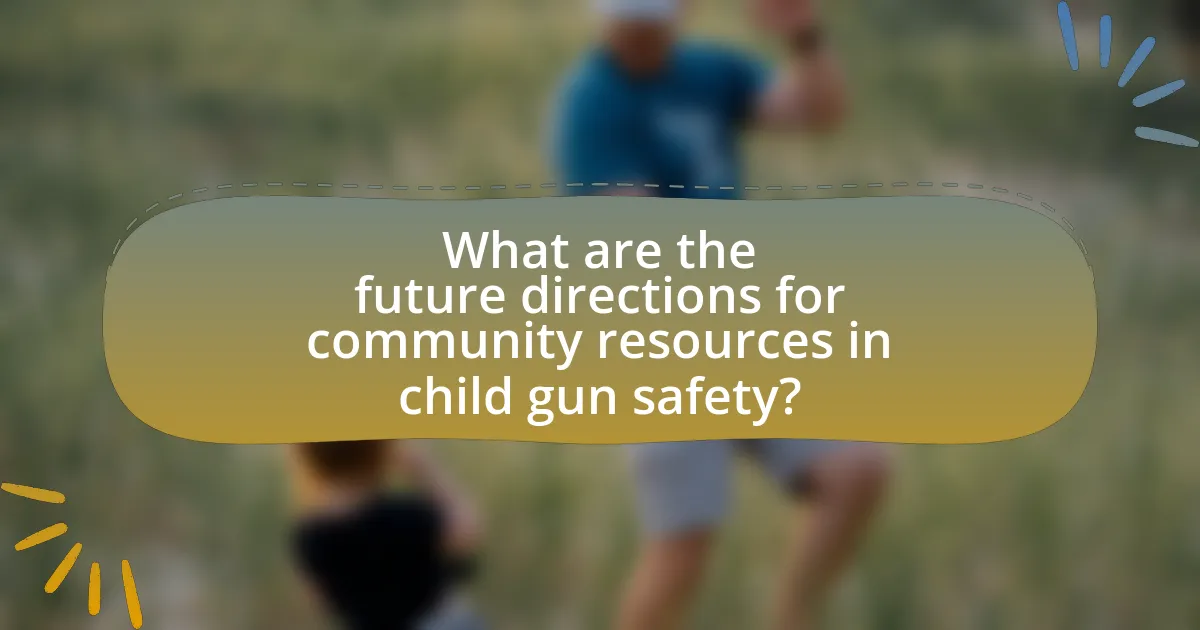
What are the future directions for community resources in child gun safety?
Future directions for community resources in child gun safety include the development of comprehensive educational programs, increased collaboration between local organizations, and enhanced access to safe storage solutions. Educational programs will focus on teaching children and parents about gun safety, emphasizing the importance of secure storage and responsible handling. Collaboration among schools, law enforcement, and community groups will foster a unified approach to gun safety initiatives, ensuring that resources are effectively utilized. Additionally, providing affordable or free access to gun safes and lockboxes will encourage responsible ownership and reduce the risk of accidental shootings among children. These strategies are supported by research indicating that education and safe storage significantly decrease the likelihood of firearm-related incidents involving children.
How can technology be leveraged to promote child gun safety?
Technology can be leveraged to promote child gun safety through the development of smart gun technology, educational apps, and safety monitoring systems. Smart guns, equipped with biometric locks, ensure that only authorized users can fire the weapon, significantly reducing the risk of accidental discharges by children. Educational apps can provide interactive learning experiences about gun safety, teaching children the importance of not touching firearms and how to seek help from adults. Additionally, safety monitoring systems can alert parents if a firearm is accessed or moved, allowing for immediate intervention. Research indicates that states with stricter gun safety laws and technology integration have seen a decrease in accidental shootings among children, highlighting the effectiveness of these technological solutions in enhancing child safety.
What innovative programs are emerging in communities to address gun safety?
Innovative programs emerging in communities to address gun safety include community-based gun buyback initiatives, educational workshops on safe storage practices, and youth engagement programs that promote responsible gun ownership. For instance, cities like Los Angeles have implemented gun buyback programs that incentivize individuals to surrender firearms, resulting in the removal of thousands of guns from circulation. Additionally, organizations such as the National Shooting Sports Foundation offer educational resources that teach families about safe firearm storage, which is crucial in preventing accidental shootings among children. These programs are supported by research indicating that safe storage practices significantly reduce the risk of firearm-related incidents involving children.
How can data and research inform future community strategies for gun safety?
Data and research can inform future community strategies for gun safety by identifying trends, risk factors, and effective interventions. For instance, studies have shown that communities with comprehensive gun safety education programs experience a significant reduction in accidental shootings among children. Research published in the American Journal of Public Health indicates that states with stricter gun laws and community-based safety initiatives report lower rates of firearm-related injuries. By analyzing data on gun violence incidents, demographics, and the effectiveness of existing programs, communities can tailor their strategies to address specific needs and allocate resources more effectively.
What practical steps can communities take to improve child gun safety today?
Communities can improve child gun safety today by implementing educational programs that teach children about the dangers of firearms and safe handling practices. These programs can be conducted in schools, community centers, and through local organizations, ensuring that children receive consistent messaging about gun safety. Research indicates that educational interventions can significantly reduce accidental shootings among children; for instance, a study published in the Journal of the American Medical Association found that children who participated in gun safety programs were 70% less likely to engage in unsafe behaviors around firearms. Additionally, communities can promote the use of gun locks and safe storage practices through local initiatives, providing resources and incentives for families to secure firearms properly. By combining education with practical safety measures, communities can create a safer environment for children regarding gun access and usage.
What resources are available for parents to educate their children about gun safety?
Parents can access various resources to educate their children about gun safety, including the National Rifle Association’s Eddie Eagle GunSafe Program, which provides educational materials and safety tips for children. Additionally, the American Academy of Pediatrics offers guidelines and resources for discussing gun safety with children, emphasizing the importance of secure storage and communication. The Centers for Disease Control and Prevention also provides statistics and information on gun-related injuries, which can help parents understand the risks and the importance of safety education. These resources collectively support parents in fostering a safe environment for their children regarding gun safety.
How can community members actively participate in promoting gun safety?
Community members can actively participate in promoting gun safety by organizing educational workshops and community events focused on safe gun storage and handling practices. These initiatives can include partnerships with local law enforcement and gun safety organizations, which provide expert knowledge and resources. For instance, studies show that communities with active gun safety programs experience a significant reduction in accidental shootings and gun-related injuries among children, highlighting the effectiveness of community engagement in this area.
